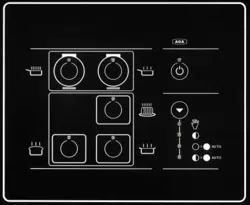Loading ...
Loading ...
Loading ...

24
8. Cleaning & Caring for your Range
REMEMBER: be careful of the hot appliance.
For most cleaning it is best when the appliance is
turned o.
DO NOT use a steam cleaner to clean this range.
DO NOT use abrasive pads, caustic cleaners, oven
cleaners or metal scrapers to clean the surfaces of
the enamel.
The touch control panel may be cleaned with a damp
cloth and warm soapy water.
IMPORTANT: AGA recommend Vitreous Enamel
Association approved cleaners for cleaning the
vitreous enamelled surfaces of this product
obtainable from your AGA Retailer.
When cleaning use as little water as possible.
DO NOT immerse the doors in water as they are
packed with insulating material, which will be
damaged by excessive moisture.
DO NOT put oven doors or resting plates in a
dishwasher.
Top Plate and Front Plate
The easiest way to clean the AGA top plate and front
plate is to mop up spills as they happen.
Baked on food is more dicult to clean but can
usually be removed with proprietary vitreous
enamel cleaners or mild cream cleaners using a
cloth, or if necessary, a nylon scouring pad.
If milk or fruit juice, or anything containing acid is
spilt on the enamel, wipe o immediately.
Clean o any condensation streaks on the front
plate, around the oven doors or any vitreous enamel
maybe permanently discoloured.
All that is usually needed to keep the vitreous
enamelled surfaces of your range bright and clean
is a daily rub over with a damp, soapy cloth followed
immediately with a clean, dry cloth to avoid streaks.
Remember the top plate and the polished covers will
scratch if pans or utensils are dragged across them.
To keep the vitreous enamel surfaces of the range bright
and clean, a daily rub over with a damp soapy cloth followed
immediately with a clean, dry cloth to avoid streaks is all that
is required. AGA E-cloths are excellent for this, obtainable
from your AGA Retailer.
Cast iron ovens and hotplates
Ovens - are made from cast iron and keep themselves clean.
They are very durable, but will rust if surface moisture is left
on them. Remember to always switch the ovens on, to dry
them out after cleaning.
Heating up the ovens periodically will help burn o any
cooking deposits to aid cleaning within the ovens.
To season the ovens, a light vegetable spray oil (corn oil is
best) is recommended. Any stubborn stains can be removed
with the wire brush supplied.
Hotplates - is made from cast iron, and is easy to care for.
Regular maintenance will ensure long-life. They will rust if
surface moisture is left on them
Should the hotplates become soiled, use a sponge, cloth,
scouring pad or wire brush to remove burnt-on spills.
Rinse o detergents or cleaning agents thoroughly.
Remember to switch on the hotplate for a few minutes to dry
it after cleaning. Every now and then, apply a thin coating of
vegetable oil (corn oil is best) when the hotplate is cold.
Lids and oven door/lids linings
The top of the insulated cover (lid) - this is chrome or
stainless steel and can be kept clean by wiping over with a
damp cloth and polished up - the AGA E-cloths are excellent
for this purpose as they are lint-free and eco-friendly. AGA
stainless steel and chrome cleaner are recommended to
keep the insulated cover clean and shining. These can be
purchased from your local AGA Specialist.
Lining of the insulated cover (lid interior) - the use of an
AGA splash shield is recommended to keep the lining free of
fat splashes, obtainable obtainable from your AGA Retailer.
If the lining is marked it is best cleaned when the hotplate is
cold. It can be cleaned with hot soapy water and/or a cream
cleanser. If badly marked then a soap impregnated pad can
be used - this should be used in a circular motion.
The rst few times a soap impregnated pad is used you will
see the circular marks, these will become reduced and the
surface of the lining becomes shinier each time when used.
Do not use excessive water and make sure the lining is dry
before closing the cover.
Oven door linings - the linings can be cleaned with hot
soapy water, a cream cleanser or soap impregnated pad. To
deep clean the lining place a towel on the work surface and
carefully lift o the oven door (doors are heavy) and place it
enamel side down on the towel padding. Clean with a soap
impregnated pad to remove stubborn marks. Dry o before
replacing on their hinges.
WARNING: ACCESSIBLE PARTS MAY BECOME HOT DURING USE. TO AVOID BURNS AND SCALDS CHILDREN
SHOULD BE KEPT AWAY.
Loading ...
Loading ...
Loading ...
